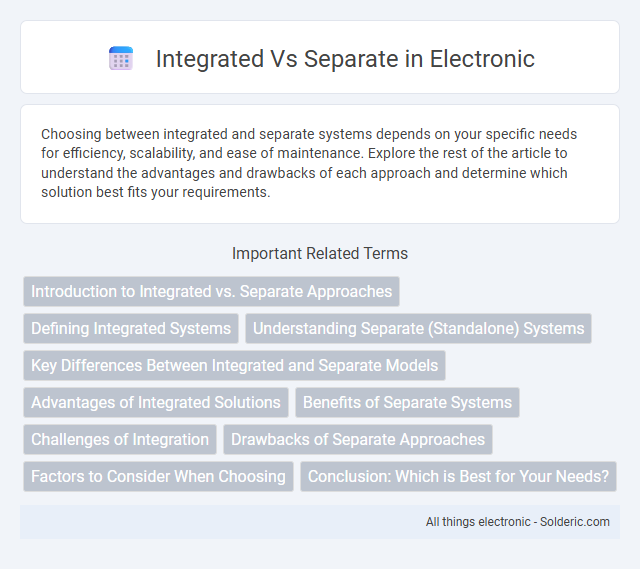Choosing between integrated and separate systems depends on your specific needs for efficiency, scalability, and ease of maintenance. Explore the rest of the article to understand the advantages and drawbacks of each approach and determine which solution best fits your requirements.
Comparison Table
| Feature | Integrated System | Separate System |
|---|---|---|
| Definition | All components combined into a single system. | Components operate independently and separately. |
| Installation | Simpler setup, one unit to install. | More complex; multiple units require individual installation. |
| Maintenance | Easier, centralized maintenance. | Requires separate servicing for each component. |
| Cost | Usually lower upfront cost. | Higher initial investment. |
| Flexibility | Limited customization options. | Highly customizable and scalable. |
| Performance | Optimized for integrated operation. | Potentially higher performance with specialized units. |
| Space Efficiency | Compact and space-saving design. | Requires more space due to separate units. |
| Use Case | Ideal for small-to-medium projects. | Best for large or complex systems. |
Introduction to Integrated vs. Separate Approaches
Integrated and Separate approaches refer to different methods of managing system components or processes in software development and organizational workflows. The integrated approach combines multiple functions or systems into a unified framework, enhancing coordination and data consistency, while the separate approach maintains distinct, independently operating modules, allowing for specialization and modular flexibility. Choosing between integrated and separate approaches depends on factors such as scalability, complexity, and the need for real-time data synchronization or independent system upgrades.
Defining Integrated Systems
Integrated systems combine multiple functions or components into a single unified platform, enhancing efficiency and data consistency across operations. These systems streamline workflows by centralizing processes like accounting, inventory, and customer relationship management, reducing the need for manual data transfers. Your business benefits from improved real-time insights and reduced operational silos with an integrated approach.
Understanding Separate (Standalone) Systems
Separate (Standalone) systems operate independently without relying on external components, offering greater control and customization for your specific needs. These systems enhance security by limiting integration points that could expose vulnerabilities, making them ideal for sensitive or isolated environments. However, they may require more maintenance and effort to manage data consistency compared to integrated solutions.
Key Differences Between Integrated and Separate Models
Integrated models combine processes and functions into a unified system, enhancing real-time data sharing and improving efficiency across departments. Separate models maintain distinct, isolated systems for each function, which can limit communication and slow down decision-making due to data silos. Key differences include the level of system cohesion, data accessibility, and operational flexibility, with integrated models favoring seamless collaboration and separate models supporting specialized, independent workflows.
Advantages of Integrated Solutions
Integrated solutions streamline your business operations by combining multiple functions into a single platform, reducing compatibility issues and improving data consistency. They enhance efficiency through centralized management and real-time data sharing, enabling faster decision-making and collaboration. These solutions also minimize maintenance costs and simplify training by providing a unified user experience.
Benefits of Separate Systems
Separate systems offer enhanced security by isolating critical data, reducing the risk of widespread breaches. They provide greater flexibility, allowing organizations to customize each system specifically to its function without compromise. Maintenance and troubleshooting become more manageable, as issues can be identified and resolved within individual systems without impacting others.
Challenges of Integration
Challenges of integration often stem from incompatible systems, leading to data silos and workflow disruptions. Managing diverse software platforms requires advanced synchronization to ensure real-time data accuracy and operational efficiency. Your organization must address these technical complexities and potential security risks to achieve seamless integration.
Drawbacks of Separate Approaches
Separate approaches in system design can lead to inefficiencies, such as increased maintenance costs and difficulties in data synchronization across disparate components. Fragmented processes often result in slower decision-making and reduced scalability due to isolated workflows and inconsistent information flow. Your business may face challenges with integration complexity and limited real-time coordination when relying on separate systems rather than an integrated solution.
Factors to Consider When Choosing
Choosing between integrated and separate systems requires evaluating factors such as budget constraints, scalability needs, and ease of maintenance. Integrated systems often offer streamlined workflows and lower upfront costs but may lack flexibility, whereas separate systems can provide greater customization and better performance at the expense of complexity. Assessing current infrastructure compatibility, future growth plans, and user training requirements is essential for making an informed decision.
Conclusion: Which is Best for Your Needs?
Choosing between integrated and separate audio systems depends on your specific needs, budget, and space constraints. Integrated systems offer convenience and compact design ideal for casual listeners or small spaces, while separate components typically provide superior sound quality and customization options preferred by audiophiles. Evaluate your priorities in sound performance, flexibility, and ease of use to determine the best fit for your audio setup.
Integrated vs Separate Infographic

 solderic.com
solderic.com